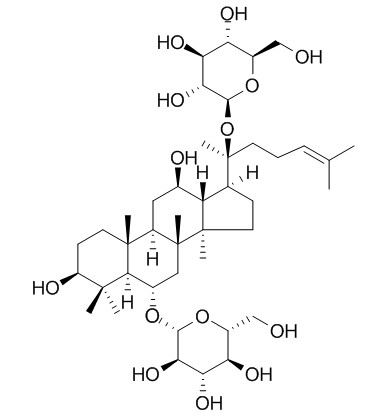Natural Products
Ginsenoside Rg1
| Catalog No. | CFN99967 |  |
| CAS No. | 22427-39-0 | |
| Molecular Weight: | 801.01 | |
| Molecular Formula | C42H72O14 | |
| DBs | [PubChem]:11138 [ChEMBL]:67987 [PCIDB]:3520 |
Standard InChI:
InChI=1S/C42H72O14/c1-20(2)10-9-13-42(8,56-37-34(52)32(50)30(48)25(19-44)55-37)21-11-15-40(6)28(21)22(45)16-26-39(5)14-12-27(46)38(3,4)35(39)23(17-41(26,40)7)53-36-33(51)31(49)29(47)24(18-43)54-36/h10,21-37,43-52H,9,11-19H2,1-8H3/t21-,22+,23-,24?,25?,26+,27-,28-,29+,30+,31?,32-,33?,34?,35-,36+,37-,39+,40+,41+,42-/m0/s1
Biological Activity
Ginsenoside Rg1 is the main pharmacologically active compound of ginsenosides and has demonstrated pharmacological effects in the cardiovascular system, central nervous system and immune system; Rg1 has protective effect against Aβ25-35-induced toxicity in PC12 cells,might be through the insulin-like growth factor-I receptor (IGF-IR) and estrogen receptor (ER)signaling pathways.[1]
Ginsenoside Rg1 is often recommended for its antiaging effects,Rg1 supplementation improved the performance of aged mice in behavior test and significantly upregulated the expression of synaptic plasticity-associated proteins in hippocampus, including synaptophysin, N-methyl-D-aspartate receptor subunit 1, postsynaptic density-95, and calcium/calmodulin-dependent protein kinase II alpha, via promoting mammalian target of rapamycin pathway activation.[2]
Ginsenoside Rg1 increases the expression of the vascular endothelial growth factor (VEGF) mRNA and reduces expression of transforming growth factor beta (TGF-B) mRNA in wounded skin , suggests that Rg1 should be helpful for the promotion of wound healing.[3]
Ginsenoside Rg1 is a desirable agent for enhancing CD4+ T-cell activity, as well as the correction of Th1-dominant pathological disorders, which by increasing Th2 specific cytokine secretion and by repressing Th1 specific cytokine production.[4]
Ginsenoside Rg1 promotes proliferation, migration, adhesion and in vitro vasculogenesis.[5] Rg1 inhibits platelet activation via the inhibition of ERK pathway, and attenuates arterial thrombus formation in vivo.[6]
Ginsenoside Rg1 possesses the neuroprotective effects on inducing differentiation of ES cells into neurons in vitro via the GR-MEK-/2-K-signaling pathway.[7]
Product
Official website: Ginsenoside Rg1
Japanese website: Ginsenoside Rg1
Chinese website: Ginsenoside Rg1
Japanese website: Ginsenoside Rg1
Chinese website: Ginsenoside Rg1
References
[1] Chen W F, Zhou L P, Chen L, et al. Neurochem Int, 2013, 62(8):1065-71.
[2] Yang L, Zhang J, Zheng K, et al. Journals of Gerontology, 2014, 69(3):282-94.
[3] 임애경, 김길수, 박수정, et al. 한국식품영양과학회지, 2010, 39(10):437-45.
[4] Lee E J, Ko E, Lee J, et al. Int Immunopharmaco, 2004, 4(4):235-44.
[5] Shi A W, Wang X B, Lu F X, et al. Acta Phamacol Sin, 2009, 30(3):299-306.
[6] Zhou Q, Jiang L, Xu C, et al. Thromb Res , 2014, 133(1):57-65.
[7] Wu J, Pan Z, Cheng M, et al. Neurochem Int , 2012, 62(1):92-102.
[8] Jia G, Li M A, Han F. Journal of Tianjin University of Traditional Chinese Medicine, 2011(1):41-42.
[2] Yang L, Zhang J, Zheng K, et al. Journals of Gerontology, 2014, 69(3):282-94.
[3] 임애경, 김길수, 박수정, et al. 한국식품영양과학회지, 2010, 39(10):437-45.
[4] Lee E J, Ko E, Lee J, et al. Int Immunopharmaco, 2004, 4(4):235-44.
[5] Shi A W, Wang X B, Lu F X, et al. Acta Phamacol Sin, 2009, 30(3):299-306.
[6] Zhou Q, Jiang L, Xu C, et al. Thromb Res , 2014, 133(1):57-65.
[7] Wu J, Pan Z, Cheng M, et al. Neurochem Int , 2012, 62(1):92-102.
[8] Jia G, Li M A, Han F. Journal of Tianjin University of Traditional Chinese Medicine, 2011(1):41-42.
Product Use Citation





